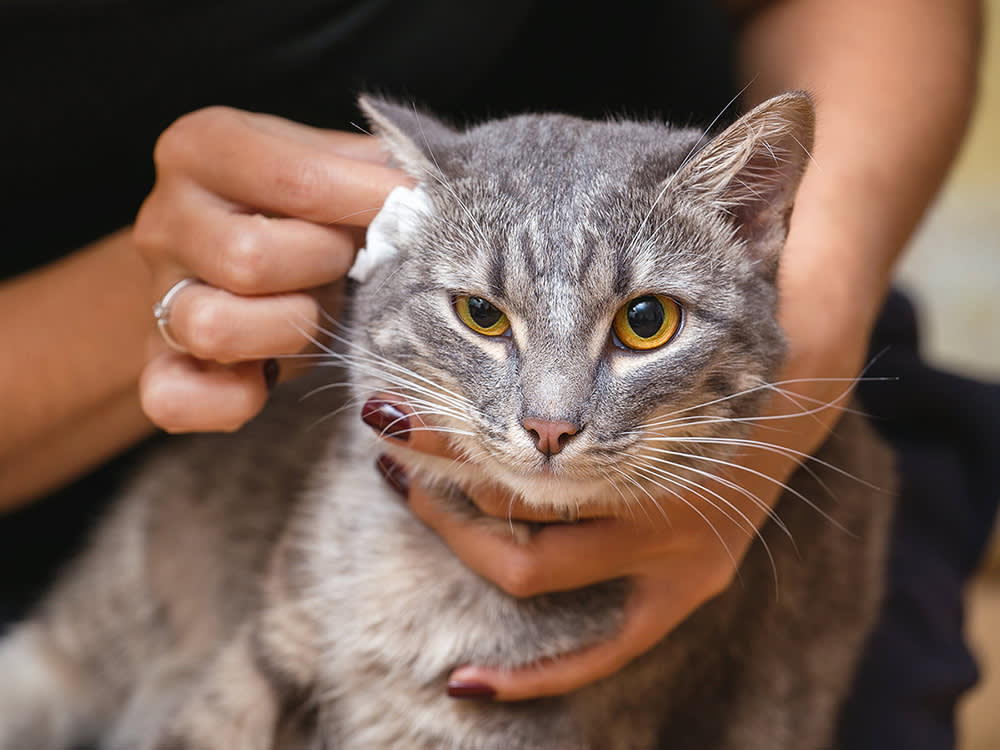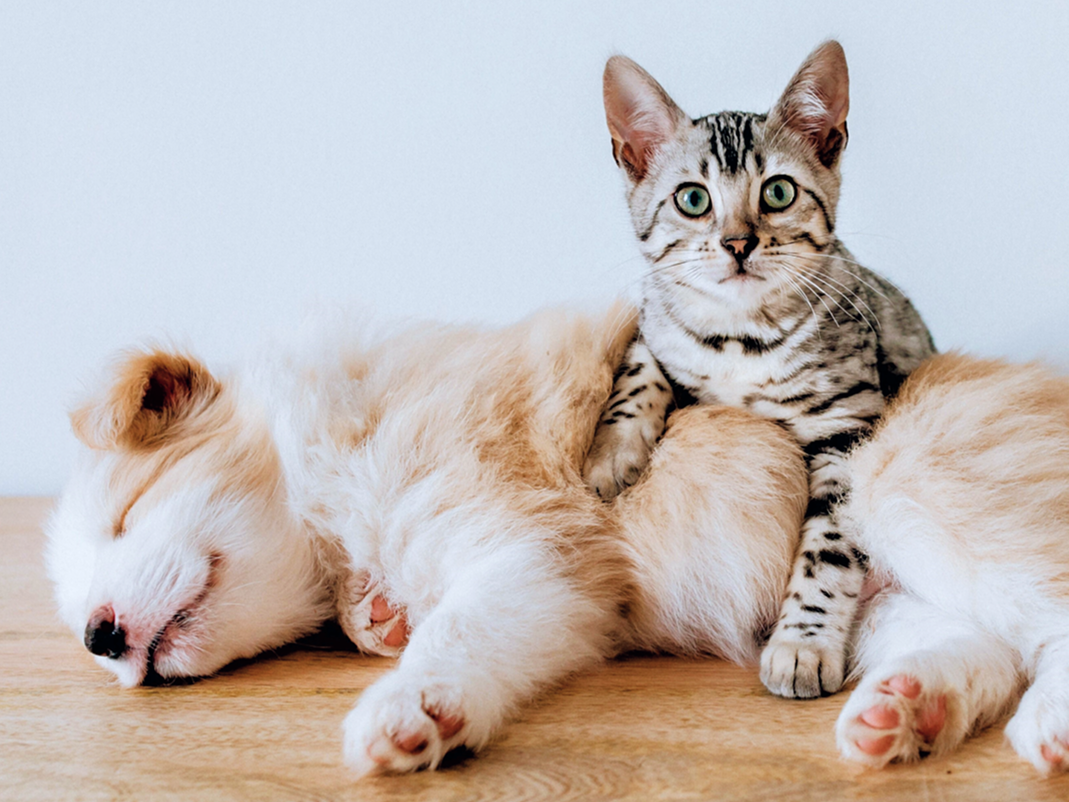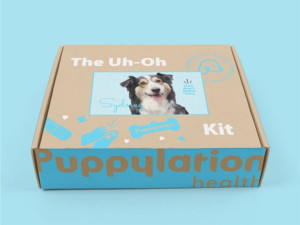Cat First Aid 101
From performing CPR to preventing shock, three vets break down everything you need to know to help your cat in an emergency.
You’ve heard the old adage: Cats always land on their feet. Well, sometimes they don’t, and since emergencies have a way of always happening at random hours when vet offices are closed (how convenient), it’s important to be prepared just in case. So we asked three veterinarians — Dr. Lynn Buzhardt, Dr. Ryan Llera, and Dr. Ernest Ward — to explain all things ER, from what “first aid” even means to how to help your cat in different scenarios. Then, author and adventure cat expert Laura Mossopens in new tab chimed in to share what’s in her cat’s first aid kit.
What is first aid, anyway?
Dr. Llera: First aid is initial treatment given in a medical emergency. Its purpose is to preserve life, reduce pain and discomfort, and/or minimize any risk of permanent disability or disfigurement.
Check out customizable policies from our friends at Lemonade Pet Insurance—so you only pay for what you need.
What’s the first thing to do in an emergency?
Dr. Llera:
Keep calm and assess the scene for any additional threats to you or your pet. This is important for everyone’s safety.
Keep your cat warm (except in cases of heat stroke), as quiet as possible, and keep movement to a minimum, especially if there is possible trauma, broken limbs, or any symptoms of neurological damage.
Contact your veterinary hospital, inform them of the situation, and get specific first aid advice.
To safely move or transport an injured cat, use a suitable container such as a strong cardboard box or a cat carrier (remove the top for easy and safe access to the carrier; do not push an injured cat through the small door or opening). Place a blanket or thick towel over the patient.
Get to the veterinary hospital as soon as possible.
What if my cat is struggling?
Dr. Ward: Most pets will be panicked or disoriented. The stress of an emergency can cause your otherwise friendly cat to act aggressively. Although many panicky animals respond to a calm, soothing voice, use caution when approaching or touching any injured animal.
How much do you spend on your pet per year?
You can wrap the body of a frightened or unmanageable cat in a blanket or towel. Do not constrict the trachea or airway. If possible, leave the head exposed, unless the cat is very aggressive. Use caution if you are suspicious of a fractured bone or spinal injury, in which case you should lay the cat in a large box.
What if my cat goes into shock (and what does that even mean)?
Dr. Ward: Shock is a whole body reaction to a number of situations. These include severe trauma, hemorrhage or sudden blood loss, heart failure, and other causes of decreased circulation (e.g. severe and sudden allergic reaction and heat stroke). A life-threatening fall in blood pressure is a dangerous part of shock. If not treated quickly and effectively, systemic shock may cause irreversible injury to body cells, and it can be fatal.
Dr. Llera: Signs of shock include rapid breathing which may be noisy; rapid heart rate with a weak pulse; pale gums, lips, under eyelids; severe depression; cool extremities (limbs and ears), and vomiting. If your cat is showing any of these signs, keep them as quiet as possible and try to conserve heat by covering them with blankets, towels, or even newspapers. Then follow the A, B, Cs of first aid:
Airway
Anything that obstructs the airway prevents oxygen entering the lungs. Do your best to clear the mouth and throat of any obstruction such as vomit, saliva, or other foreign material. Be careful — your pet may bite you in panic.
Breathing
If the cat is unconscious and does not appear to be breathing, try gently pumping the chest with the palm of your hand, at the same time feeling just behind the elbow to detect a heartbeat or pulse. If this is unsuccessful, give the pet CPR (see below). Be careful — injured pets may bite you out of fear. If you are unsure about the health or vaccination status of the injured pet, avoid contact with bodily fluids and blood.
Heartbeat
If you are unable to detect a heartbeat or pulse, or if it appears weak and slow, try pressing on the chest with your palm and elevate the lower half of the body to promote blood flow to the brain. Then perform CPR.
How do I perform CPR on my cat?
Dr. Llera: When you encounter an unresponsive cat, the first step is to ensure that there is an open airway.
Carefully pull the tongue out of the mouth.
Extend the head and neck so that they are in a straight line. DO NOT overextend the neck in animals that have obvious head and neck trauma.
Carefully clear the mouth of any debris that may be obstructing breathing.
Place your hand over the cat’s mouth and extend the neck. For cats, you can sometimes improvise with a styrofoam cup or other similar shaped object by putting the opening over the cat’s face and poking a large hole in the bottom for you to breathe through. Ensure a relatively tight seal around the muzzle.
Blowing into the nostrils, give two to three breaths and watch for a rise in the chest. If you do not see a rise in the chest, reposition the neck or search for airway obstruction.
If you believe there is an airway obstruction that you cannot see, turn the cat upside down, with the back against your chest. Give five sharp thrusts to the rib cage to try and expel any object.
For CPR, provide 20 breaths per minute.
If the cat fails to breathe on their own, you may attempt an acupressure maneuver. Press firmly with your fingernail or other hard object in the space between the nostrils and the upper lip. Do this for 10-30 seconds.
What if my cat requires chest compressions?
Dr. Ward: After you have established an airway and begun CPR, if there are still no obvious signs of life you should attempt chest compressions.
Make sure there is no major bleeding. If there is bleeding, have an assistant manage the bleeding (see below) while you perform chest compressions.
If possible, lay the cat on their right side.
Feel for a heartbeat or femoral pulse. The femoral pulse is located inside the leg in the groin region. Cats do not have a readily palpable neck pulse.
Bend the left forearm and note the location where the elbow touches the chest. This is close to the middle of the rib cage.
Use one hand to compress the chest from both sides by putting your fingers on one side and your thumb on the other side of the chest. Compress the chest 100-120 times per minute. The rate should be about 30 compressions for every 2 breaths.
Try to compress the chest wall at least 30-50%. This is about 1" (2 cm) in the average cat.
How can common emergencies be treated with first aid?
Dr. Ward:
Blood loss
Once you have followed A, B, C above, if the bleeding is severe, try to stop it. If bleeding is from a cut pad or paw, apply a dressing using a piece of absorbent bandage or clothing. If the bleeding persists and is soaking through the bandage, do not waste any more time and get to your veterinarian, since this is a medical emergency. Most bleeding wounds will require medical or surgical treatment. If the wounds are treated within four hours, they can often be sutured. Deep cuts treated after four hours have increased risk of infection and complication, and require more extensive surgery.
Burns and scalds
Cool the burned area with cold water as quickly as possible. Cover the burned area with damp towels. If the injury is due to a caustic substance, rinse with cold water for 15 minutes and contact your veterinarian for further advice. Animals that have been exposed to heat or smoke from a fire should be offered water as soon as the situation is stable.
Eye injuries
Injuries to the eye are always very painful and can threaten the eyesight. If a foreign body (grass awn, hair, piece of a claw, etc.) can be seen, it may be possible to remove it by gently rinsing the eye with eye wash or contact lens saline solution (be sure to check that there are no other ingredients and it is ONLY saline solution). Do not allow the cat to scratch or rub the eye. Seek veterinary advice as soon as possible.
What first aid is recommended for falls?
Dr. Buzhardt: Sprains, broken bones, head trauma, and chest or abdominal injuries may result from a feline tumble. Serious injuries from falls need to be immediately evaluated and treated by a veterinarian, but here are first aid steps to implement at home as you prepare to take your cat to the veterinary clinic:
Monitor breathing
If your cat struggles to breathe, proceed right away to the nearest emergency clinic. Remember that cats are “nose breathers,” so panting is a sign of respiratory distress. Transporting cats with respiratory problems need to be done very carefully, especially if ribs were broken. Support your cat behind the front legs and in front of the back legs and gently place them in a pet carrier. If you don’t have a pet carrier, use a rigid object like a baking sheet as a gurney. Cats with broken ribs should stay very still to avoid lung puncture, so don’t let them struggle — if they prefer to lie down or sit up, let them do it.
Protect open wounds
If the skin was broken during the fall, wrap a clean towel over the area to minimize contamination. It is particularly important to cover a wound that has a broken bone protruding from it. Bone infections can seriously complicate healing. Puncture wounds to the abdomen should also be covered to minimize infection from outside contaminants; however, if the intestines are punctured, infection could start from within. Your veterinarian will assess this problem.
Control bleeding
If the wound is bleeding, wrap the towel tightly around the injured site and apply gentle, but firm pressure. If the towel becomes soaked, do not remove it. Just put another towel on top of it to avoid disturbing the clot. Most bleeding stops within five to 10 minutes; however, cats with clotting disorders may take longer. Excessive bleeding may occur if the spleen or liver was injured, so prompt emergency care is vital.
Monitor the cat for several hours
Sometimes, cats appear normal after a fall as they walk around and play. Later, they become lethargic and weak or develop difficulty breathing, so it’s important to monitor them closely for several days after a fall. Delayed injuries include collapsed lungs caused by punctures from broken ribs, or hernias that start as small openings and rip open later.
Diaphragmatic hernias occur when there is a tear in the wall separating the chest from the abdomen. If abdominal organs (liver, stomach, intestines) move into the chest cavity, respiration is impaired. Hernias may also occur in the abdominal wall, creating pockets that trap intestines, bladder, or other organs. These delayed problems are emergencies that require prompt attention. Transport the cat with the injured side down as you head to the veterinary clinic.
Look for head injuries
Blood in the eyes, nose, or mouth means possible head injury. Cats will usually swallow blood that pools in the mouth and lick blood that flows from the nose, so there is no need to control the bleeding. Just proceed to the veterinary clinic.
Be aware of back injuries
A cat that can’t get up at all may have sustained a back injury and should be kept as still as possible. Gently place the cat on a rigid object like a baking sheet. Cover them with a blanket and seek emergency help.
Monitor eating and bathroom habits
Broken jaws occur frequently when cats fall. Watch your cat eat and drink. If they drop food, yelp when they chew, or drool excessively, have them examined by your veterinarian. Monitor their peeing and pooping. If they don’t have a normal BM within 48 hours or if they don’t pee within 24 hours, seek help. Your cat may have ruptured their bladder or the bladder may be impinged in an abdominal hernia. Lack of normal urination and defecation can be signs of something serious.
What should I have in my cat’s first aid kit?
Laura Moss: Whether you’re adventuring with your cat or just lounging around at home, it’s important to have these things on hand (preferably in a waterproof case), in the event of an emergency. Here’s what your feline first-aid kit should contain?
Phone numbers and addresses for your veterinarian, the local 24-hour emergency vet and the ASPCA Poison Control Centeropens in new tab: (888) 426-4435
Paperwork for your cat (The Humane Societyopens in new tab suggests including proof of rabies-vaccination status, copies of other important medical records, and a current photo of your pet.)
Any medication your vet has prescribed
Absorbent gauze pads
Adhesive tape
Antiseptic wipes, lotion or spray
Cotton balls or swabs
Hydrogen peroxide
Eyewash (The human version is OK to use.)
Ice pack
Non-latex disposable gloves
Rectal thermometer
Petroleum jelly to lubricate the thermometer
Gauze rolls
Sterile non-stick gauze pads for bandages (The Humane Society recommends self-cling bandages. This type of bandage sticks itself — but not to fur — and is available at pet stores.)
Scissors with blunt ends
Tweezers or tick key (Your cat should be up to date on flea, tick, and heartworm treatments before heading outside.)






